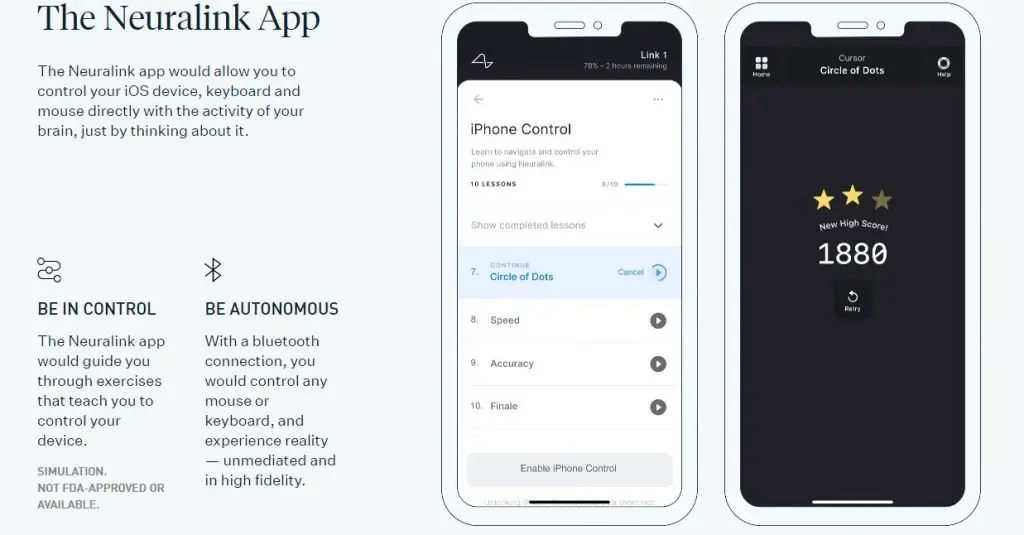Elon Musk is frequently in the news for Tesla and SpaceX, two well-established companies that he is at the helm of. Then there are Starlink (internet provider) and The Boring Company (infrastructure and tunnel construction services company), which are in the news fairly regularly. But there is another company that the billionaire has founded.
Neuralink is a neurotechnology company that develops brain-machine interfaces. Musk has previously said that people suffering from serious brain injuries will benefit from Neuralink’s vision. The core idea is to embed chips into a human brain and understand the signals sent out by the brain for every single activity that goes on inside your body. They will then attempt to send these signals to a computer, which will mean you essentially control some functions on a computer, such as moving the cursor, using your brain.
Today, the company has released a video of a nine-year-old monkey Pager carrying out some actions on a computer using his brain. Scientists at Neuralink have embedded two chips, known as Link, into Pager’s brain. They have then wirelessly connected the chip to a computer. The video shows Pager controlling a cursor and clicking on small illuminated boxes on the screen. The video also shows Pager playing “Pong”, a famous video game from our childhood.
A Brief Description of the Video
The scientists at Neuralink embedded one chip (Link) on either side of Pager’s brain six weeks ago. Earlier, the Links recorded data from more than 2,000 electrodes inside the motor control sector of Pager’s brain. They managed to understand the signals which Pager’s brain was sending to its right arm in order to bring the cursor on the illuminated boxes on the screen in front of him.
Using this, they were able to identify the exact neuron-to-neuron signals travelling through his brain for specific movements, such as moving his hand upwards, or to the right. They then sent this data to a decoder, which can predict the intended movement of Pager’s hand in real-time. They calibrate the decoder using the joystick that Pager uses to play the game. This is followed by matching the neural activity to the movement of the joystick.
Now, instead of feeding data to the decoder, they let the decoder send out signals to the computer instead of the joystick. This means that the brain is now sending signals to the decoder, which it forwards to the computer, and continues to play the game. So, in essence, Pager is controlling the cursor using his brain. Scientists at Neuralink hope to use the same technique to help paralyzed patients control a computer or a mobile phone.
Of course, this is much more complicated than what Pager did. Paralyzed patients won’t be able to control a joystick. So the decoder will have to take signals when the patients imagine that they are doing certain actions. But what they have done with Pager is a huge step in neurotechnology. The video also shows Pager playing the video game “Pong” using signals sent from its brain.
Neuralink’s Basic Working
We know that neurons communicate through electric signals. When a neuron receives the ‘right’ combination of input, it initiates an action potential. Neuralink takes advantage of this by placing electrodes near neurons to detect action potentials. Recording from many neurons allows them to decode the information represented by those cells.
The reason for connecting electrodes directly to the brain is quite simple. Recordings made from a distance (such as through EEGs) provide some useful, high-level information. But in order to access fine-scale information, you need to be close to the source of these signals.
This is followed by artificial neural stimulation. By stimulating in the right temporal sequences across many electrodes, it is possible to create patterns of activity that elicit the desired sensation, like the feel of an object in your hand.
Neuralink is designing the first neural implant that will let you control a computer or mobile device anywhere you go. This will consist of inserting micron-scale threads into areas of the brain that control movement. Each thread contains many electrodes and connects them to the implant, the Link.
The actual process of embedding this chip inside your brain will be a highly automated neurosurgery. The threads on the Link are so fine and flexible that they can’t be inserted by the human hand. So, the company is building a robotic system that the neurosurgeon can use to reliably and efficiently insert these threads exactly where they need to be.
You can then control a mobile or computer through the Neuralink app. There is a guide in the app that gives you exercises to teach you how to control your device. And this is only till you are well-acquainted. After that, you can control any mouse or keyboard from anywhere, as long as you’re connected via Bluetooth.

Neuralink’s Vision
The initial goal is to help people with paralysis to regain independence through the control of computers and mobile devices. The devices give people the ability to communicate more easily via text or speech synthesis. As this technology develops, they hope to increase channels of communication with the brain. This will help in accessing more brain areas, thus resulting in new neural data.
This technology has the potential to treat a wide range of neurological disorders and to restore sensory and movement function. Finally, Neuralink hopes to achieve a level of connectivity between two Links in different brains that can help them interact with each other.
Of course, human trials haven’t begun yet, and so, there is no safety data for humans. But Neuralink claims that safety is at the very core of their design process, given that any such device needs to be safe at every single point of usage.
Our Opinion
There is also the issue of addressing security concerns. Many people are worried that if someone were to hack this chip, they could essentially have control over your brain, in a way. Of course, this will be a concern when the chip actually has control over parts of the brain, not when it is just aiding the functions. Neuralink has said that security will be built into every layer of the product. This will include strong cryptography, defensive engineering and extensive security auditing.
The video, however, shows a really extraordinary piece of technology actually working. It’s quite crazy to think that in the future, you could actually control computers and mobile phones using your brain. Of course, actual human trials may take time, considering that Neuralink will have to go through a number of regulatory committees. But the fact that they have actually managed something very close to that in a mammal very close to humans is amazing.



















keep us up to date like this. Thanks for sharing.